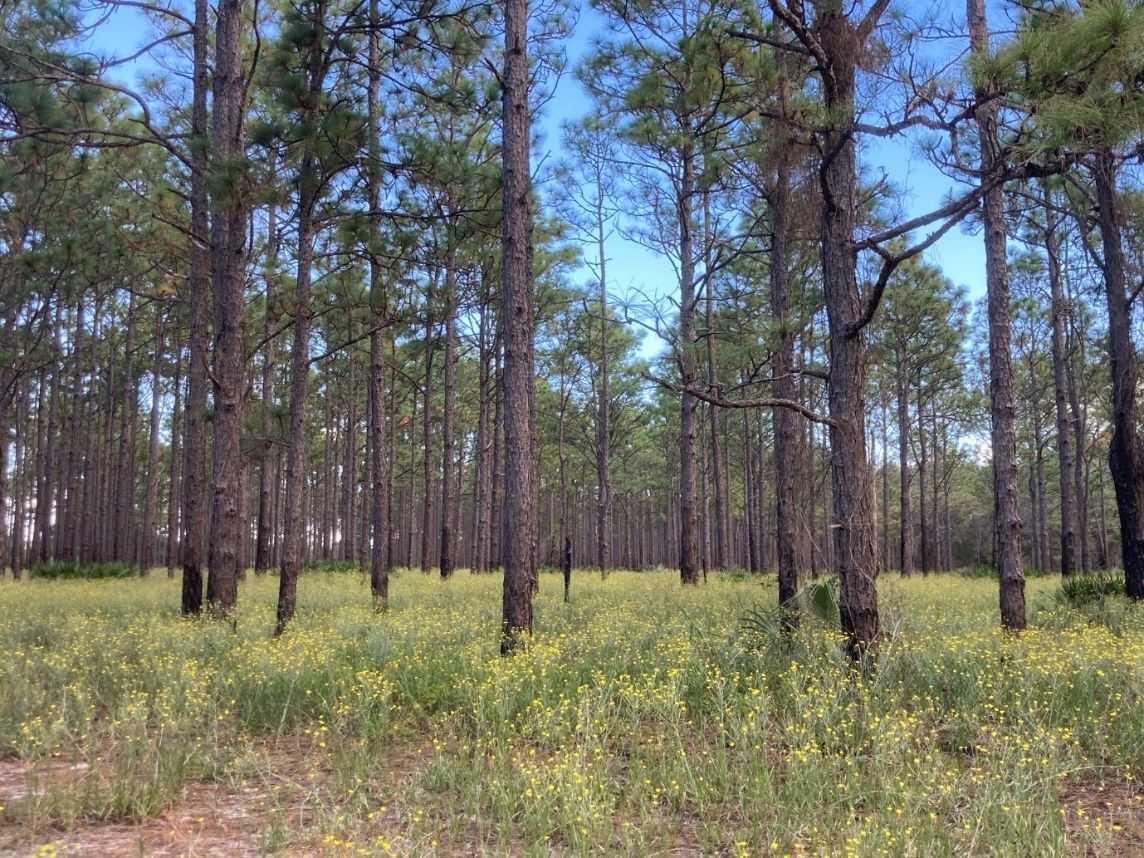Taxonomy
Family—Asteraceae (Asters) Genus — Pityopsis (Silkgrass)
Common name—The name “silkgrass” arose from the silky hairs on the leaves and overall grass-like appearance.
Description
The genus Pityopsis, or silkgrasses, as they are commonly called, are perennial forbs that look like grass and feature silver, silk-like hairs. Historically only four species of silkgrass were recognized native to Florida (Wunderlin et al. 2020). Recent phylogenetic and taxonomic work has provided evidence that there are at least nine distinct species of silkgrass that are native to Florida and one that is non-native. These nine native species of Pityopsis include Pityopsis aequilifolia, P. aspera, P. flexuosa, P. graminifolia, P. latifolia, P. microcephala, P. nervosa, P. oligantha, and P. tracyi (Hatmaker et al 2020; Weakley and Lee 2020; Semple and Jabbour 2019; and Nesom 2019). Each species of silkgrass is found within given geographic boundaries and natural communities in Florida (Weakley 2020). (See the range map, here: https://rpubs.com/gagemo/Pityopsis-Florida-RangeMap-iNat). Recognizing these different species is important for land managers who are striving to restore specific plant communities, as well as for nursery growers who sell native plant materials and distribute them throughout the state. Existing botanical keys make identification of these species challenging for those without a botanical background. This publication aims to alleviate this challenge by providing a breakdown of botanical terms useful for silkgrass species (Figure 1), along with a practical guide featuring pictures and illustrations of nine species. Additional information on phenology, seed harvesting, propagation, and its uses are also provided.

Credit: Left, Bob Peterson [CC BY 2.0]; Middle, Deanna Drosera via flickr, [CC BY-NC-ND]; Right, Lilly Anderson-Messec, [CC BY 2.0]
Range Map of Observations of Pityopsis spp in Florida Shared on iNaturalist
An interactive map, available here, shows research-grade iNaturalist observations of species within the genus Pityopsis throughout the state of Florida. (The map was made in RStudio using Leaflet and Tidyverse packages. Note that instances of P. graminifolia in central and southern Florida need further review to reflect modern taxonomy.)
A Practical Guide to Differentiating Silkgrass Species in Florida

Credit: (left) by Tom Kennedy [CC BY-NC], (right) by Scott Allen Davis [CC BY 4.0]
Species of silkgrass can be divided between those that feature basal leaves that are longer than the stem leaves and those whose basal leaves are shorter than the stem leaves.
Basal leaves shorter than stem leaves
- P. aequilifolia
- P. falcata
- P. flexuosa
- P. latifolia
Basal leaves longer than stem leaves
- P. aspera
- P. graminifolia
- P. microcephala
- P. nervosa
- P. oligantha
- P. tracyi
Pityopsis aspera (Pineland Silkgrass)
Distinguishing characteristics: Hairy pubescent leaves (< 10 mm wide), stems, peduncles, and phyllaries. Basal leaves are much longer than stem leaves. Found within sandhills and mesic flatwoods within the Panhandle and north Peninsula of Florida. There are two varieties of this species which include P. aspera var. adenolepis and P. aspera var. aspera. The primary distinguishing feature between these varieties is the presence of glands along the stems; P. aspera var. adenolepis does not have stem glands whereas P. aspera var. aspera does have stem glands.
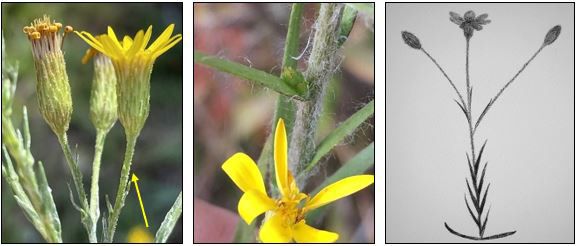
Credit: (left, middle) Becky Dill [PD], (right) illustration by Jazz Griffis
Pityopsis aspera (Pineland Silkgrass)
Distinguishing characteristics: Hairy pubescent leaves (< 10 mm wide), stems, peduncles, and phyllaries. Basal leaves are much longer than stem leaves. Found within sandhills and mesic flatwoods within the Panhandle and north Peninsula of Florida. There are two varieties of this species which include P. aspera var. adenolepis and P. aspera var. aspera. The primary distinguishing feature between these varieties is the presence of glands along the stems; P. aspera var. adenolepis does not have stem glands whereas P. aspera var. aspera does have stem glands.
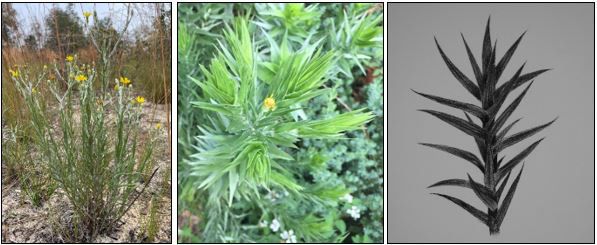
Credit: (left) by Brett Budach [CC BY-NC]; (middle) philanderin [CC BY-NC], (right) illustration by Jazz Griffis
Pityopsis falcata (Sickleleaf Silkgrass)
Distinguishing characteristics: Falcate (hook-shaped) leaves that diverge from the stem. Basal leaves are shorter or equal to stem leaves. This species is native to North America but is not native to FL. It features sparsely localized naturalization near Tampa, Florida.
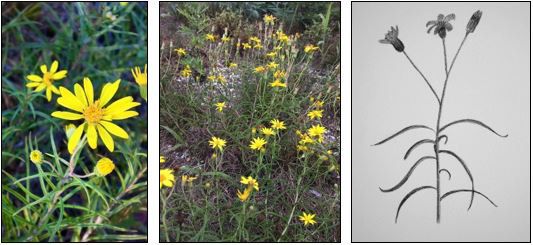
Credit: (left, center) Daniel Atha [PD], (right) illustration by Jazz Griffis
Pityopsis flexuosa (Zigzag Silkgrass)
Distinguishing characteristics: Stems that are bent or zigzag from each node. Basal leaves are shorter or equal to stem leaves. Found in sandhills within the western half of the Florida Panhandle region.
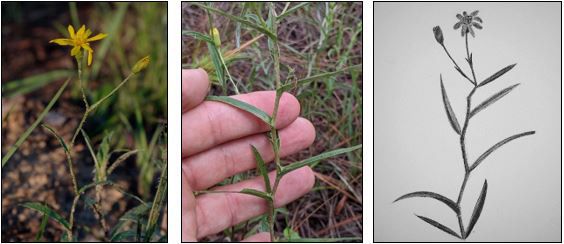
Credit: (left, middle) by Scott Allen Davis, [CC BY 4.0], (right) illustration by Jazz Griffis
Pityopsis latifolia (Broadleaf Silkgrass)
Distinguishing characteristics: Basal leaves are oblanceolate (rounded leaf) and are shorter than the the stem and upper leaves. Disc florets exceed 30 per flowering head. This species is found only within Florida xeric white sand scrub in central and south Peninsula in Florida.
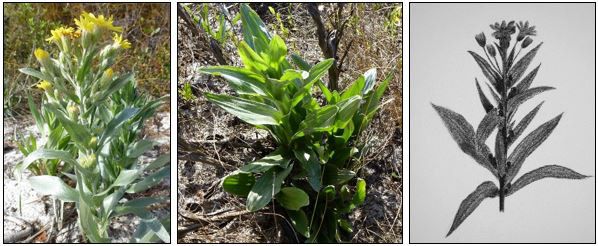
Credit: (left, middle) Edwin Bridges [Used with permission], (right) illustration by Jazz Griffis
Pityopsis graminifolia (Narrowleaf Silkgrass)
Distinguishing characteristics: The peduncles, upper stems, and phyllaries feature few to no glands. Fewer than 30 disc florets (flower heads) per stem. The stem leaves only slightly overlap, and overall there are fewer stem leaves when compared to P. aequilifolia. The basal leaves are much longer than the stem leaves as well.Found within the Panhandle and Peninsula regions of Florida.
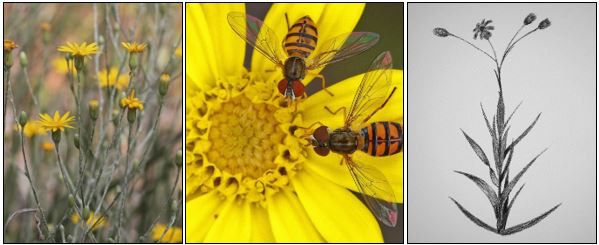
Credit: (left, middle) by Mary Keim via iNaturalist [CC BY-NC-SA], (right) illustration by Jazz Griffis
Note that species P. microcephala, and P. nervosa are not included in this guide. Both are extremely similar to one another and to P. graminifolia. All three species occur within the same habitats, but P. graminifolia is generally thought to be less common than P. microcephala and P. nervosa. Historically, P. microcephala was treated as P. graminifolia var. tenuifolia, whereas P. nervosa was treated as P. graminifolia var. latifolia. All three species are primarily differentiated based on the structuring and features of their phyllaries. P. microcephala is differentiated from P. graminifolia by its inner phyllaries, which are densely stipitate-glandular (small glands supported by extremely small stalk-like structures), whereas P. graminfolia possesses far fewer of these features. P. nervosa is distinguished from P. graminfolia and P. microcephala chiefly by its phyllaries, which are found in unequal series and vary in shape from outer to inner.
Pityopsis oligantha (Bog Silkgrass)
Distinguishing characteristics: Fewer than ten flowering heads per stem. Basal leaves are much longer than stem leaves. The only Pityopsis species that is found principally in wet soils. Restricted to seepage slopes, wet flatwoods, wet prairies, and the margins of cypress domes and marsh communities.
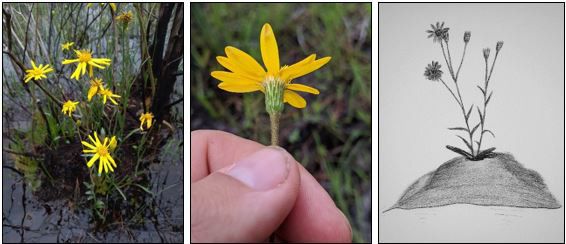
Credit: (left) by Scott Ward [CC-BY], (middle) by Scott Allen Davis [CC-BY], (right) illustration by Jazz Griffis
Pityopsis tracyi (Tracy's Silkgrass)
Distinguishing characteristics: Disc florets exceed 30 per flowering head. This species is often regarded as the most robust species of Pityopsis in Florida. Flowering heights often range from 50–100 cm. Basal leaves are large ranging from 15–30 cm long.
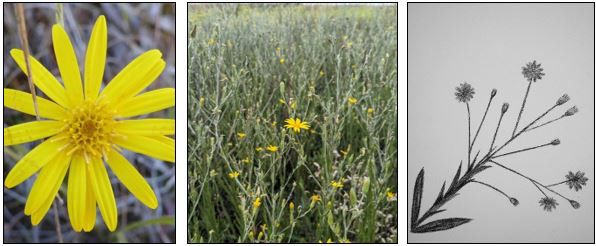
Credit: (left) by Edwin Bridges [CC-BY-NC], (middle) by Nate Martineau [CC-BY-NC], (right) illustration by Jazz Griffis
Notes on Phenology
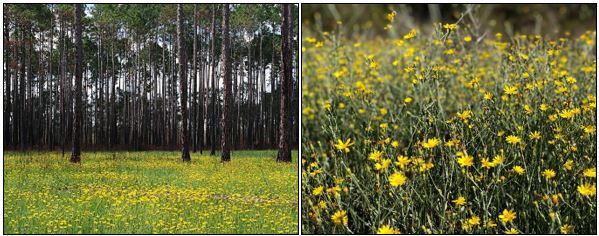
Credit: (left) by Steve Coleman, [used with permission], (right) by Deanna Drosera via flckr [CC BY-NC-ND]
Generally, the growth of silkgrasses starts slowly in the spring and accelerates in warm weather during the summer months (USDA, NRCS 2007). Typically, silkgrasses will flower in Florida from September through November (USDA, NRCS 2007; Brewer et al. 1994). However, it is not unusual to see populations flowering during spring and summer months. In Florida, the seed from silkgrass species will often mature in November to January (USDA, NRCS 2007). In the wild, the seed germinates during winter months after rains from cold fronts. Both the phenology and growth habit of this species are greatly affected by the seasonal timing of fire (Brewer et al. 1994; Brewer and Platt 1994a; Brewer and Platt 1994b; Gowe and Brewer 2005; Simkin et al. 2001; Brewer 1995; Lindon and Menges 2008). Several studies conducted by Stephen Brewer and William Plattfound that fire during the late spring and summer induces a higher rate of flowering, a greater number of shoots/clones, improved seedling emergence, and increased overall fecundity in comparison to winter fires (Brewer et al. 1994; Brewer and Platt 1994a; Brewer and Platt 1994b; Brewer 1995). As a result, land managers and seed producers may see an increase in silkgrass stand health and seed production from periodic burning (or cutting) during those periods.
Applications
All silkgrass species except for P. aequilifolia are rhizomatous. This aspect makes drought-adapted species such as P. trayci and P. graminifolia well suited for use in erosion control and rehabilitation of sites affected by mining and overgrazing (USDA, NRCS 2007). The capacity for high seed production and viability makes these two species ideal for use in groundcover restoration and enhancement projects as well.

Credit: (left) Bob Farley [CC BY-NC-ND] (right) Kim Connolly [CC-BY-NC]
Forage
Livestock and wildlife are known to graze silkgrass, especially directly after fires (USDA, NRCS 2007). These species are seldom in high enough abundance to support livestock long-term, but light grazing from wildlife or livestock is apparently not destructive to silkgrass and not thought to greatly affect its mortality.
Wildlife
The flowers and largescale blooms of silkgrasses often attract and support a wide diversity of pollinators (see Table 1) (Deyrup, Eidirisinghe, and Norden 2002). This includes mining bees, plasterer bees, wasps, bumble bees, sweat bees, leaf cutting bees, ground nesting bees, and many different species of moths, wasps, and butterflies (Deyrup, Eidirisinghe, and Norden 2002). Silkgrasses are also a source of forage for grasshoppers, gopher tortoises, and whitetail deer, which are known to browse the buds of silkgrass, as well as the new growth after burns (USDA, NRCS 2007).
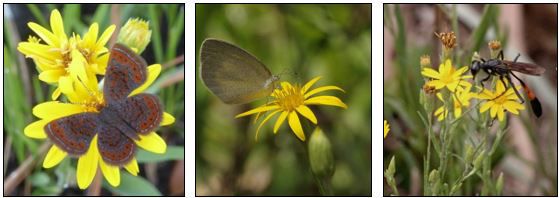
Credit: (left) by Edwin Bridges (used with permission) [CC-BY-NC], (middle, right) by Mary Keim [CC BY-NC-SA]
Table 1. Species of pollinators currently known to interact with Pityopsis (Deyrup, Eidirisinghe, and Norden 2002).
Urban Landscaping
Silkgrasses feature benefits that make them widely employable for use in urban landscaping around homes, gardens, and meadows (Thetford et al. 2009; Zinn 2014). Silkgrass foliage, for example, is unaffected by freezes and largely resistant to a wide variety of pests. All species feature a silky texture and aqua color that make them unique and appealing additions in landscapes. The yellow flowers of silkgrasses are attractive and help support a wide range of pollinators. Most species of silkgrass are adapted to sandy and sunny areas with soil conditions ranging from xeric to mesic. Most species can also tolerate disturbed or compacted soils to an extent. Their ability to be mowed periodically also makes them an excellent option for urban meadows and human-constructed grasslands. Pityopsis tracyci and Pityopsis graminifolia are commercially available and can be found by searching the Florida Association of Native Nurseries catalog (FANN 2023).
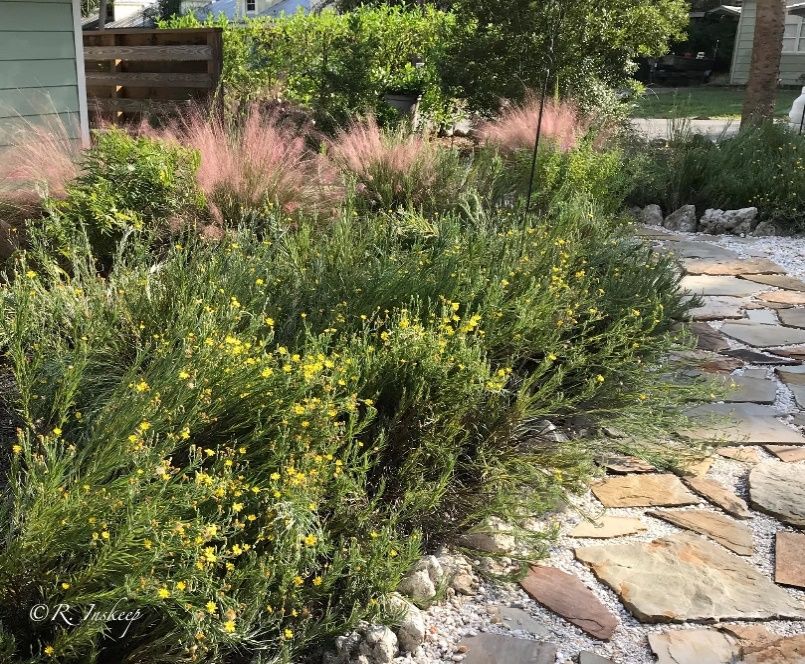
Credit: Ryan Robert [used with permission]
Silkgrass can be mowed and may benefit from annual biomass removal. Cutting back aboveground stems that have senesced flowers will induce and increase the number of flowers for that season. Often this is done after the fall flowering season and during the winter or early spring when seeds are released or consumed by wildlife. However, silkgrass may also be cut back or mowed in the late spring and early summer months to encourage floral synchronicity and proliferation of reproductive ramets that may lead to a greater number of fall flowers.
Propagation
Silkgrass is readily propagated by seed. Seeds should be collected after they ripen and turn black when they are most easily removable from the flower head (Kujawski, Englert, and Dusty 2001). Seeds typically ripen and mature in Florida from late October to December; southern populations may ripen later into January. Strong winds from cold fronts may cause rapid dispersion of seeds. Collection of seeds can be effectively performed with a vacuum cleaner or leaf vacuum. Seeds from wild populations have reported germination rates as high as 65% in the literature. For ornamental purposes, rhizomatous silkgrass species such as Pityopsis trayci can also be readily propagated by division.
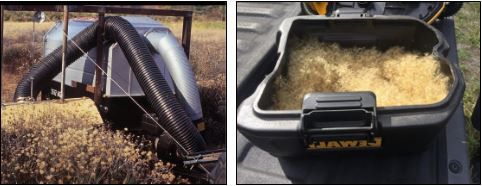
Credit: (left) by John M Englert taken from Kujawski et al. 2001, (right) by Gage LaPierre, UF/IFAS
Propagation Trial at the UF/IFAS Native Plant Nursery
Pityopsis trayci was grown out from seed at the UF/IFAS Native Plant Nursery from 2020 to 2021. The seeds were collected from Austin Cary Forest in November of 2020 and sown in March of 2021. The seeds were sown in a greenhouse featuring natural lightningat 25/15ºC. Seeds were sown via light press (1 cm depth) into a soil substrate consisting of peat, perlite, and vermiculite (5:3:2). The containers used were 2" x 2⅛" x 1.5" and manufactured by Anderson Pot Company. Exactly 123 seeds germinated out of 196 seeds (62% germination rate). Two weeks after germination, plants were fertilized using 1 teaspoon of slow-release pellets of Osmocote Plus 15-9-12. After eight weeks, plants were transplanted into one-gallon nursery pots (100% survival) and were ready for out-planting in another four weeks.
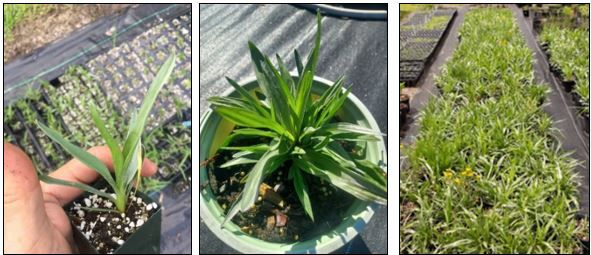
Credit: (left) (middle) (right) by Gage LaPierre, UF/IFAS
References
Brewer, S. J. 1995. “The Relationship between Soil Fertility and Fire-Stimulated Floral Induction in Two Populations of Grass-Leaved Golden Aster, Pityopsis graminifolia.” Oikos 74:45–54. https://doi.org/10.2307/3545673
Brewer, J. S., and W. J. Platt. 1994. “Effects of Fire Season and Herbivory on Reproductive Success in a Clonal Forb, Pityopsis Graminifolia.” Journal of Ecology 82:665–675. https://doi.org/10.2307/2261273
Brewer, J. S., and W. J. Platt. 1994. “Effects of Fire Season and Soil Fertility on Clonal Growth in a Pyrophilic Forb, Pityopsis graminifolia (Asteraceae).” American Journal of Botany 81:805–814. https://doi.org/10.1002/j.1537-2197.1994.tb15561.x
Brewer, J. S., W. J. Platt, J. S. Glitzenstein, and D. R. Streng. 1994. “Effects of Fire-Generated Gaps on Growth and Reproduction of Golden Aster (Pityopsis graminifolia).” Bulletin of the Torrey Botanical Club 123:295–303. https://doi.org/10.2307/2996778
Deyrup, M., J. Edirisinghe, and B. Norden. 2002. “The Diversity and Floral Hosts of Bees at the Archbold Biological Station, Florida (Hymenoptera: Apoidea).” Insecta mundi 16:87–119.
Gowe, A. K., and J. S. Brewer. 2005. The Evolution of Fire-Dependent Flowering in Goldenasters (Pityopsis spp.). The Journal of the Torrey Botanical Society 132:384–400. https://doi.org/10.3159/1095-5674(2005)132[384:TEOFFI]2.0.CO;2
Hatmaker, E. A., P. A. Wadl, T. A. Rinehart, J. Carroll, T. S. Lane, R. N. Trigiano, M. E. Staton, and E. E. Schilling. 2020. “Complete Chloroplast Genome Comparisons for Pityopsis (Asteraceae).” PLoS One 15, e0241391. https://doi.org/10.1371/journal.pone.0241391
Kujawski, J., J. Englert, D. Dusty, and J. Ugiansky. 2001. Equipment Modifications for Harvesting Fluffy Seeds Native Plants Journalhttps://doi.org/10.3368/npj.2.2.114
Lindon, H. L., and E. Menges. 2008. “Effects of Smoke on Seed Germination of Twenty Species of Fire-Prone Habitats in Florida.” Castanea 73:106–110. https://doi.org/10.2179/0008-7475(2008)73[106:EOSOSG]2.0.CO;2
Nesom, G. L. (2019). Taxonomic synopsis of pityopsis (asteraceae). Phytoneuron, 2019 (1):1-31.
Simkin, S. M., W. K. Michener, and R. Wyatt. 2001. “Plant Response Following Soil Disturbance in a Longleaf Pine Ecosystem.” The Journal of the Torrey Botanical Society 128:208–218. https://doi.org/10.2307/3088712
Thetford, M., J. G. Norcini, B. Ballard, and J. H. Aldrich. 2009. “Ornamental Landscape Performance of Native and Nonnative Grasses under Low-Input Conditions.” HortTechnology 19 (2): 267–285. https://doi.org/10.21273/HORTTECH.19.2.267
USDA, NRCS. 2007. Plant Fact Sheet “Narrowleaf Silkgrass Pityopsis graminifolia (Michx.) Nutt.” Prepared by: Shawn Belt and Mary Ann Gonter. Contributed by: USDA NRCS National Plant Materials Center (NPMC), Beltsville, Maryland. Edited 2007. Recovered from The PLANTS Database (http://plants.usda.gov, 12/13/2023). National Plant Data Team, Greensboro, NC USA. https://plants.usda.gov/DocumentLibrary/factsheet/pdf/fs_pigr4.pdf
Weakley, A. S., and M. T. Lee. 2020. “Flora of the Southeastern United States.” https://fsus.ncbg.unc.edu/
Wunderlin, R. P., B. F. Hansen, A. R. Franck, and F. B. Essig. 2023. Atlas of Florida Plants (http://florida.plantatlas.usf.edu/). [S. M. Landry and K. N. Campbell (application development), USF Water Institute.] Institute for Systematic Botany, University of South Florida, Tampa.
Zinn, T. 2014. 10 Easy Wildflowers: Your guide to Florida native wildflowers for landscapes. Florida Wildflower Foundation. https://www.flawildflowers.org/wp-content/resources/pdfs/Publications/10EasyWildflowers.pdf
